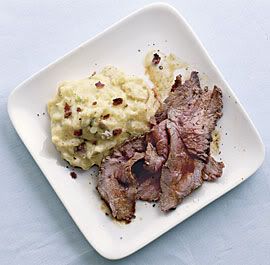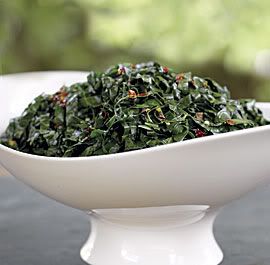Hi Myrna,
Always happy to help. I always said that I was a storehouse of totally trivial information. This cake actually tastes better than it sounds. Of course, I can't eat it like I used to, but I can still remember.
Here's another recipe that I personally don't eat, at least not the Steak, however, I figured that the Meat lovers in the audience might like it. All the ingredients in a loaded baked potato—bacon, scallions, cheese, and sour cream—are added to mashed potatoes in this hearty meal.
Smoky Rib-Eye Steaks With Loaded Mashed Potatoes

2 lb. Yukon Gold potatoes, scrubbed and cut into 1-inch chunks
4 slices thick-cut bacon
2 boneless beef rib-eye steaks (about 2 lb. total)
1-1/2 tsp. sweet smoked paprika
Kosher salt and freshly ground black pepper
1/2 cup whole milk
2 Tbs. unsalted butter
3 oz. grated sharp Cheddar (3/4 cup)
1/2 cup sour cream
2 medium scallions, thinly sliced
Arrange a steamer basket in a large pot with 1 inch of water in the bottom. Spread the potatoes in the basket in an even layer, cover, and bring to a boil. Reduce the heat to medium low and steam until the potatoes are tender, about 15 minutes.
Meanwhile, cook the bacon in a large cast-iron skillet over medium heat, turning once, until crisp, 7 to 8 minutes total. Transfer the bacon to a paper-towel-lined plate; discard all but 1 Tbs. of the fat from the skillet.
Season the steaks all over with the paprika, 1-1/2 tsp. salt, and 1/2 tsp. pepper. Heat the skillet with the reserved bacon fat over medium-high heat. Arrange the steaks in the skillet in a single layer. Cook, flipping once, until deep golden-brown outside and medium rare inside, 10 to 12 minutes total. Transfer the steaks to a cutting board and let rest for 5 minutes.
Meanwhile, transfer the hot potatoes to a large bowl. Stir in the milk and butter and mash with a potato masher until just combined. Stir in the cheese, sour cream, scallions, and salt and pepper to taste.
Slice the steaks across the grain and transfer to dinner plates. Serve the potatoes on the side with the bacon crumbled on top. Serves 4.
The trick to quick-cooking this side dish of collards (which are typically braised slowly for tenderness) is cutting them into very thin slices. All these need is a quick spin in a hot pan with olive oil to give them a delicate texture and a deep, toasty flavor. This whole recipe takes less than 20 minutes to prepare.
Quick-Sauteed Collard Ribbons

1 Tbs. malt vinegar
2 tsp. maple syrup
1-1/2 lb. collard greens (about 30 leaves)
2 Tbs. extra-virgin olive oil
4 small cloves garlic, lightly smashed and peeled
Pinch crushed red pepper flakes
Kosher salt
In a small bowl, whisk the malt vinegar and maple syrup.
Trim the stem from each collard leaf with a sharp knife, dividing the leaf completely in half lengthwise as you cut away the stem. Discard the stems; wash and dry the leaves.
Stack half of the leaves and roll them up tightly crosswise into a cigar shape. Using a very sharp knife, cut the collard “cigar” crosswise into 1/4-inch-thick slices. Use your fingers to unfurl the slices, which will be tightly curled together. Repeat with the second half of the leaves.
In a 12-inch nonstick skillet, heat the olive oil and the garlic over medium-high heat. Cook, stirring and flipping the garlic, until it’s fragrant and just lightly browned, about 3 minutes. Remove and discard the garlic. Add the pepper flakes, stirring to distribute in the hot oil, and immediately add the collards and 1/2 tsp. salt. Using tongs, stir and toss the collards until they’re coated with the oil, and continue tossing until they are slightly wilted, about 1 minute. Most of the greens will have turned a bright green, with some beginning to turn a darker green. Do not overcook, as they will become tough. Take the pan off the heat, drizzle on the maple-vinegar mixture, stir well, and transfer to a shallow serving platter. Serve immediately.
Serves 3-4.

Have A Terrific Tuesday,
Phil